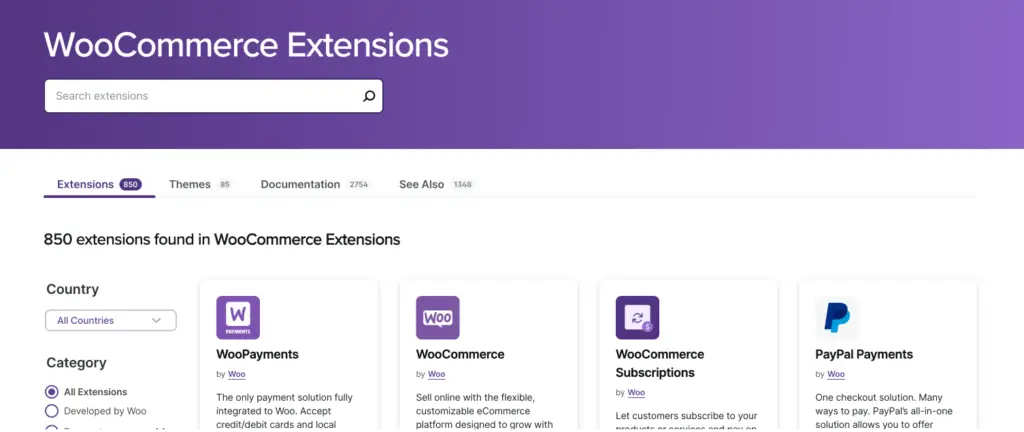Selecting the right eCommerce platform is crucial for the success of your online business. It impacts everything from the user experience and site performance to security and scalability. With numerous options on the market, finding the perfect fit can be challenging. That’s why we’re here to help you understand if WooCommerce is the right choice for your needs.
In this comprehensive WooCommerce Software Review, we will cover everything you need to know about this platform. We’ll delve into its key features and capabilities, explore the installation and setup process, and evaluate its customization options and extensions. Additionally, we’ll examine the platform’s performance and security features, user experience, pricing, and available support. By the end of this review, you’ll have a clear understanding of WooCommerce’s strengths and weaknesses, helping you make an informed decision for your e-commerce venture.
1. Overview of WooCommerce
WooCommerce was launched in 2011 by WooThemes, a company known for creating WordPress themes. Since its inception, WooCommerce has grown to become one of the most popular e-commerce solutions globally, powering millions of online stores. In 2015, WooThemes was acquired by Automattic, the company behind WordPress.com, further solidifying WooCommerce’s integration with the WordPress ecosystem and expanding its development and support resources.
Key Features and Capabilities
WooCommerce offers a wide range of features that make it a versatile eCommerce platform:
- Product Management: Easily add, edit, and categorize products with attributes, tags, and images.
- Inventory Management: Track stock levels, set inventory alerts, and manage stock for multiple products.
- Order Management: Handle orders efficiently with automated email notifications, order status updates, and the ability to manage refunds.
- Payment Gateways: Integrate with popular payment gateways like PayPal, Stripe, and Square, and accept various payment methods.
- Shipping Options: Configure shipping rates, zones, and methods, including free shipping, flat rates, and real-time calculations.
- Tax Settings: Automatically calculate taxes based on customer location, product type, and tax rules.
- Marketing Tools: Utilize built-in features for creating coupons, discounts, and promotions to boost sales.
Target Audience
WooCommerce is designed to cater to a wide range of businesses, from small startups to large enterprises. Its flexibility and scalability make it suitable for:
- Small Businesses: Entrepreneurs and small business owners who need an affordable and customizable eCommerce solution.
- Medium-sized Businesses: Companies looking to expand their online presence with advanced features and integrations.
- Large Enterprises: Big businesses that require a robust and scalable platform to handle high volumes of traffic and transactions.
2. Installation and Setup
Installing WooCommerce is straightforward, especially for those familiar with WordPress. The plugin can be installed directly from the WordPress dashboard by searching for “WooCommerce” in the plugins directory and clicking “Install Now.” Once installed, activating the plugin initiates the setup wizard.
System Requirements
To run WooCommerce effectively, ensure your system meets the following requirements:
- WordPress Version: Latest version of WordPress (always recommended to keep WordPress updated)
- PHP Version: PHP 7.4 or greater
- MySQL Version: MySQL 5.6 or greater, or MariaDB 10.1 or greater
- Web Server: Apache or Nginx
- Secure Sockets Layer (SSL): Recommended for secure transactions
Initial Setup Process
After activating the plugin, WooCommerce guides users through an intuitive setup wizard:
- Store Details: Enter basic information about your store, including address, currency, and preferred units.
- Industry: Select the industry your store operates in to tailor the setup process.
- Product Types: Choose the types of products you’ll be selling (physical, digital, subscriptions, etc.).
- Business Details: Provide additional details about your business to receive relevant tips and recommendations.
- Theme Setup: Choose a theme or continue with your existing WordPress theme.
User-Friendly Aspects
WooCommerce is known for its user-friendly interface that simplifies the eCommerce management process:
- Intuitive Dashboard: The dashboard is designed for ease of use, allowing store owners to manage products, orders, and customers efficiently.
- Comprehensive Documentation: Extensive documentation and tutorials are available to help users navigate setup and configuration.
- Community Support: A large and active community of WooCommerce users and developers offers support through forums, blogs, and social media groups.
By ensuring a smooth installation and setup process, WooCommerce enables business owners to focus on what matters most – growing their online store.
3. Features and Functionality
WooCommerce provides a robust set of tools for managing products, ensuring that store owners can easily organize and present their offerings:
- Categories: Products can be grouped into categories, making it easier for customers to navigate and find what they’re looking for. Categories can be hierarchical, allowing for sub-categories to further refine organization.
- Tags: Tags offer an additional way to label and group products, enhancing searchability and product discovery.
- Attributes: Attributes such as size, color, and material allow for detailed product descriptions and variations. These attributes can be used to create variations of a product, like different sizes or colors, each with its own SKU, price, and stock level.
Inventory Management
Effective inventory management is critical for any eCommerce store, and WooCommerce excels in this area:
- Stock Levels: Track stock quantities for individual products and variations. Set up stock notifications to alert you when inventory is running low.
- Stock Status: Mark products as in stock, out of stock, or on backorder, giving customers clear information about availability.
- SKU Management: Assign unique SKU codes to products and variations for easy identification and tracking.
Order and Customer Management
WooCommerce streamlines the process of managing orders and customers:
- Order Tracking: View and update order statuses from a centralized dashboard. Orders can be marked as pending, processing, completed, on hold, canceled, or refunded.
- Customer Accounts: Customers can create accounts to track orders and save their information for faster checkouts. Store owners can also manage customer information and view order histories.
- Automated Emails: Configure automated email notifications to keep customers informed about their order status, from confirmation to shipment.
Payment Gateways and Options
Offering multiple payment options is essential for customer satisfaction, and WooCommerce supports a wide range of payment gateways:
- Built-in Gateways: WooCommerce comes with built-in support for PayPal and Stripe, allowing customers to pay with credit cards, debit cards, and PayPal accounts.
- Additional Gateways: Integrate with numerous other payment gateways through extensions, including Square, Authorize.Net, and Amazon Pay.
- Alternative Payments: Support for offline payment methods such as bank transfers, checks, and cash on delivery.
Shipping and Tax Settings
WooCommerce provides comprehensive shipping and tax settings to ensure compliance and accurate calculations:
- Shipping Options: Configure various shipping methods, including free shipping, flat rate, and real-time shipping rate calculations from carriers like UPS and FedEx.
- Shipping Zones: Define shipping zones to apply different shipping rates based on the customer’s location.
- Tax Settings: Automatically calculate taxes based on customer location, product type, and applicable tax rules. Support for complex tax scenarios, including different rates for different regions.
Marketing and Promotion Tools (Coupons, Discounts)
Marketing and promotional tools in WooCommerce help drive sales and customer engagement:
- Coupons: Create and manage discount coupons with options for percentage discounts, fixed cart discounts, and fixed product discounts. Set usage limits, expiration dates, and restrictions.
- Discounts: Apply automatic discounts based on conditions like cart total, product categories, or customer roles.
- Email Marketing: Integrate with email marketing services to send targeted campaigns and newsletters.
4. Customization and Extensions

WooCommerce works seamlessly with a wide range of WordPress themes and offers a wide range of Extensions:
- WooCommerce-Specific Themes: Numerous themes are designed specifically for WooCommerce, offering built-in compatibility and design elements tailored for eCommerce.
- Theme Customization: Many themes come with customization options, allowing you to adjust colors, fonts, and layouts without needing to write code.
- Responsive Design: Ensure your store looks great on all devices with themes that are fully responsive and mobile-friendly.
Customization Options (Colors, Fonts, Layout)
WooCommerce offers extensive customization options to match your brand’s aesthetic:
- Colors and Fonts: Easily change colors and fonts through the theme customizer or additional plugins.
- Layout Options: Customize the layout of product pages, shop pages, and checkout pages. Use page builder plugins like Elementor or WPBakery to create unique designs.
- Custom CSS: Add custom CSS for advanced styling and design tweaks.
Extensions and Plugins Marketplace
WooCommerce’s flexibility is enhanced by its extensive marketplace of extensions and plugins:
- WooCommerce Extensions: Browse thousands of extensions on the official WooCommerce marketplace, covering everything from payments and shipping to marketing and customer support.
- WordPress Plugins: Utilize the vast ecosystem of WordPress plugins to add functionality to your store, ensuring it meets all your business needs.
Examples of Popular Extensions
To illustrate the versatility of WooCommerce, here are some popular extensions:
- Payment Processors: Extensions like WooCommerce Stripe Payment Gateway, PayPal Checkout, and Square for WooCommerce enable seamless transactions.
- Shipping Calculators: Real-time shipping rate calculators from carriers like UPS, FedEx, and DHL.
- SEO Tools: Integrate with SEO plugins like Yoast SEO or All in One SEO to optimize your store for search engines, improving visibility and traffic.
By leveraging WooCommerce’s extensive features and customization options, businesses can create a tailored, efficient, and scalable online store that meets their unique needs.
5. Performance and Security
WooCommerce is designed to integrate seamlessly with WordPress, providing optimal performance and speed for online stores. Key factors influencing site performance include:
- Optimized Code: WooCommerce’s codebase is regularly updated and optimized to ensure fast loading times and efficient operation.
- Caching Solutions: Implementing caching plugins like WP Rocket or W3 Total Cache can significantly improve site speed by storing static versions of your pages.
- Content Delivery Network (CDN): Using a CDN, such as Cloudflare or Amazon CloudFront, helps to deliver content faster to users around the world by caching and distributing it from multiple servers.
- Image Optimization: Compressing and optimizing images using tools like Smush or EWWW Image Optimizer can reduce load times without sacrificing quality.
- Hosting: Choosing a reliable hosting provider with good server performance is crucial. Managed WordPress hosting providers like WP Engine, SiteGround, and Bluehost offer optimized environments for WooCommerce.
Security Features and Updates:
Security is a top priority for WooCommerce, ensuring that both store owners and customers are protected:
- Regular Updates: WooCommerce regularly releases updates to fix bugs, improve functionality, and enhance security. It’s crucial to keep WooCommerce, WordPress, and all plugins up to date.
- Secure Payment Processing: Integration with secure payment gateways ensures that transactions are encrypted and protected against fraud.
- SSL Certificate: Installing an SSL certificate encrypts data transferred between your website and your customers, providing a secure browsing experience.
- Security Plugins: Utilizing security plugins like Wordfence or Sucuri can add additional layers of protection, including firewalls, malware scanning, and login security.
- Two-Factor Authentication (2FA): Implementing 2FA for admin logins adds an extra layer of security by requiring a second form of verification.
Compliance with Industry Standards
WooCommerce adheres to various industry standards to ensure compliance and build trust with users:
- PCI-DSS Compliance: WooCommerce supports PCI-DSS compliance for handling credit card transactions securely.
- GDPR Compliance: Tools and plugins are available to help WooCommerce stores comply with GDPR, protecting customer data privacy.
- Accessibility: Many WooCommerce themes and plugins are designed with accessibility in mind, ensuring that your store is usable by people with disabilities.
6. Pricing
The core WooCommerce plugin is free to download and use, making it an attractive option for businesses of all sizes. This allows you to set up a basic online store without any initial cost.
Additional Costs for Themes, Extensions, and Hosting
While the core plugin is free, there are additional costs to consider for a fully functional and customized store:
- Themes: Premium WooCommerce themes range from $30 to $100, offering enhanced design and functionality.
- Extensions: Prices for extensions vary widely, from free to several hundred dollars, depending on the functionality you need. Popular extensions include payment gateways, shipping calculators, and marketing tools.
- Hosting: Reliable hosting is crucial for performance and security. Managed WordPress hosting plans typically range from $10 to $50 per month, depending on the provider and the level of service.
Comparison with Competitors
When compared to other eCommerce platforms, WooCommerce’s pricing is competitive:
- Shopify: Plans start at $29 per month, plus transaction fees unless you use Shopify Payments. Shopify offers an all-in-one solution but can be more expensive when considering transaction fees and app costs.
- BigCommerce: Plans start at $29.95 per month, offering a robust feature set with no transaction fees, but potentially higher costs for large businesses.
- Magento: The open-source version is free, but costs can be high for hosting, development, and extensions. Magento is suitable for larger businesses with complex needs.
7. Pros and Cons
Pros:
- Flexibility: Highly customizable with thousands of themes and extensions.
- Cost-Effective: Free core plugin with affordable additional costs.
- Scalability: Suitable for businesses of all sizes, from small startups to large enterprises.
- Integration: Seamless integration with WordPress and a vast ecosystem of plugins.
- Community Support: Extensive documentation and a large, active community.
Cons:
- Complexity: Can be complex for beginners, especially for advanced customizations.
- Performance: Site speed and performance can vary depending on hosting and configuration.
- Maintenance: Requires regular updates and maintenance to ensure security and functionality.
Comparison with Other eCommerce Platforms
- Shopify: Easier for beginners with an all-in-one solution, but less flexible and potentially more expensive.
- BigCommerce: Offers robust built-in features and no transaction fees, but fewer customization options compared to WooCommerce.
- Magento: Highly scalable and customizable, but requires more technical expertise and higher costs for hosting and development.
Conclusion
WooCommerce is a versatile and robust eCommerce platform that can be tailored to meet the needs of a wide range of businesses. Its extensive customization options and large community support make it an excellent choice for those looking to create a unique and scalable online store. However, it may require a learning curve for beginners and ongoing maintenance to ensure optimal performance.

